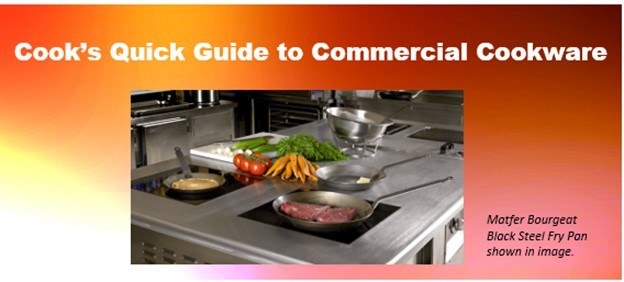There are obvious differences between a fry pan and a stock pot and most anyone that cooks knows when to use one versus the other, but do you know why you would pick up the straight sided sauce pan instead of the tapered sauce pan? Cookware design is about getting the most flavor from your ingredients, so selecting the right type of commercial cookware can impact the overall flavor of a dish. This simple outline will help you to determine the best restaurant cookware types for your menu. Take a look- and make sure to have all the right professional cookware that you need in your commercial kitchen.
Fry Pan
How is a fry pan shaped? Commercial fry pans feature curved side walls for easy stirring and sliding of food out of the pan.
How is a fry pan used? Fry pans are ideal for frying, scrambling, sautéing, or searing.
Design Tip: The sloped sides of a commercial fry pan prevent steam from forming in the pan.
Sauté Pan
How is a sauté pan shaped? Sauté pans feature a wide bottom area meant for maximum heat conduction
How is a sauté pan used? Commercial sauté pans are perfect for sautéing, searing, deglazing, poaching, and can even be used for stir frying.
Design Tip: The straight, tall sides of a sauté pan help contain ingredients during cooking and reduce potential for spattering, and all sides of the pan are exposed to heat.
Stir Fry Pan
How is a stir fry pan shaped? Stir fry pans feature deep curved sides to promote quick and easy movement of food during cooking.
How is a stir fry pan used? Stir fry pans are designed for stir frying or wok applications.
Design Tip: A stir fry pan has a flat bottom that sits level on the cooking surface where a wok will have a rounded bottom.
Saucier
How is a saucier shaped? A saucier features curved sides that make it easy for the thorough whisking of ingredients.
How is a saucier used? A commercial saucier is the right pan to sauté, brown, poach, create a stir-fry, and build a sauce.
Design Tip: A saucier is actually a hybrid sauce pan and fry pan with elements of each in the design capturing the best of both as a pan for building a sauce.
Straight Sided Sauce Pan
How is a straight sided sauce pan shaped? A straight sided sauce pan has a wide bottom area to get the greatest amount of heat conduction possible.
How is a straight sided sauce pan used? The straight sided sauce pan is the best pan option for creating and reducing sauces and cooking vegetables
Design Tip: When you are cooking with a straight sided sauce pan, you can use it with a lid to control evaporation and accelerate cooking
Tapered Sauce Pan
How is a tapered sauce pan shaped? A commercial tapered sauce pan will have a small bottom diameter for less heat exposure to the heat source
How is a tapered sauce pan used? The tapered sauce pan is perfect for cooking at lower temperatures for a longer time.
Design Tip: The tapered sauce pan features flared sides which are enable a stirring action when cooking.
Brazier/Rondo
How is a brazier or rondo shaped? A commercial brazier features a wide heating surface that allows for the cooking of vegetables and meats in limited amounts of liquid
How is a brazier used: A rondo or a brazier pan is the pan you would use when you cook food in liquid to add juices and flavor to your ingredients through a prolonged, slow cooking process.
Often professional chefs will use a brazier or rondo as a hot bath along with a tapered sauce pan for delicate heating like melting butters, warming sauces, or blanching vegetables.
Design tip: With their large diameter and short side walls, a commercial brazier or rondo is a great multi-use pot for most every kitchen.
Sauce Pot
How is a sauce pot shaped? Commercial sauce pots feature a wide bottom area that provides maximum heat conduction and sauce pots have two loop handles making it easier when pouring or moving.
How is a sauce pot used? In a commercial setting, a sauce pot is a great choice for slow cooking stews, sauces, soups, casseroles, and roasts while reducing the content.
Design tip: You can identify a sauce pot in the kitchen because they are shorter and wider than stock pots. The lower height is to make it easier to work over the pot.
Stock Pot
How is a stock pot shaped? A commercial stock pot has a smaller diameter and taller height so that it preserves liquids longer during cooking and this shape will force the liquid to bubble up through the ingredients to ensure to provide for more flavor transfer.
How is a stock pot used? The stock pot is made for foods that need to simmer on the range to develop their flavor like stocks, soups, pastas, vegetables, and seafood.
Design tip? When shopping for stockpots, you want one with a thick base so that it will provide a good slow simmer for soups, stocks, and other foods.
Griddle
How is a griddle shaped? A commercial griddle features a wide, flat bottom to provide maximum cooking area.
How is a griddle used? A commercial griddle is designed to heat or brown foods and is ideal for eggs, grilled cheese, quesadillas, or sandwiches.
Design Tip: Many chefs that cook on a griddle with some regularity, are sure to know where the griddle surface is it’s hottest for cooking and its coolest; usually the perimeter, for more delicate ingredients or to hold already cooked food and keep it warm.
